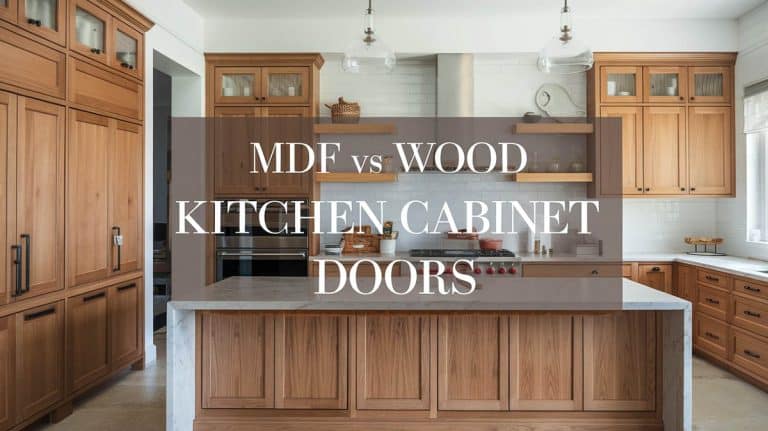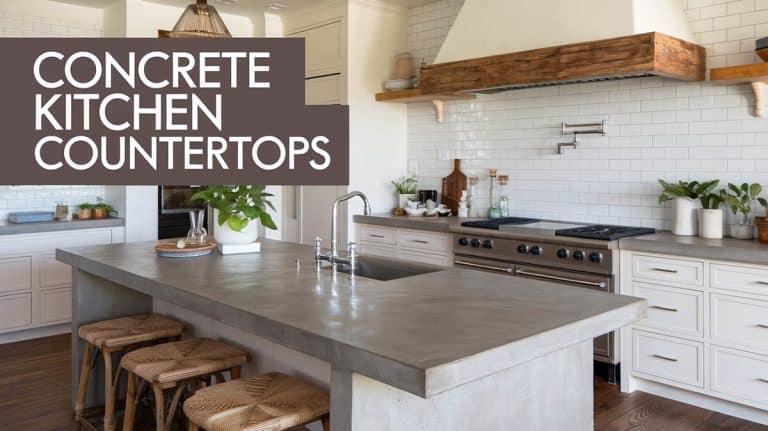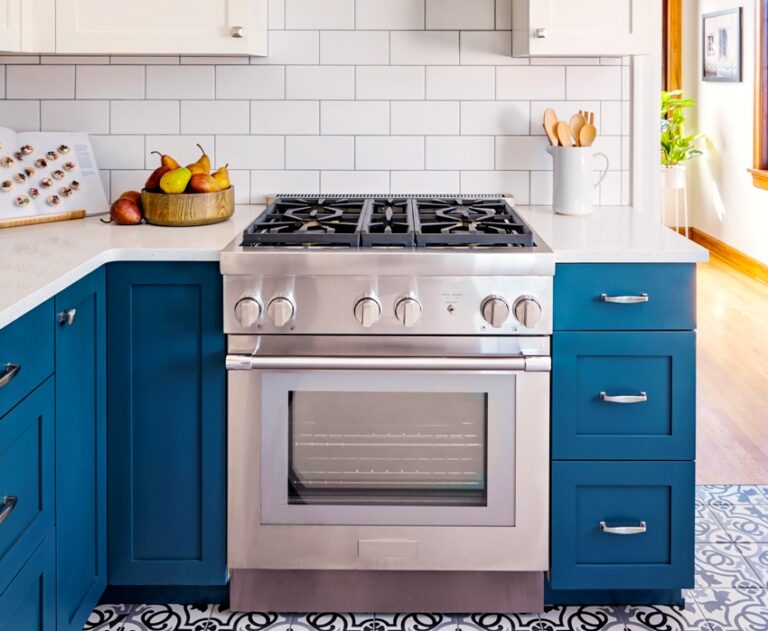Particle Board Cabinets (Pros and Cons & Painting)
In this guide, I share my knowledge about particle board cabinets, including what they are, pros and cons, designs, longevity, and I also offer tips on how to clean and paint them.

Particle board materials are known to be inexpensive but tend to be lower in quality compared to solid hardwoods or plywood. This makes homeowners hesitant to opt for cabinets made of particle boards.
However, it is best to note that there are many types of particle boards that can match specific requirements. In addition, when sourced from a reputable manufacturer, a particle board cabinet can be a sound option when the cost is an issue. Particle board cabinets allow homeowners to accomplish their storage systems without stacking up the cost.
What Are Particle Board Cabinets?
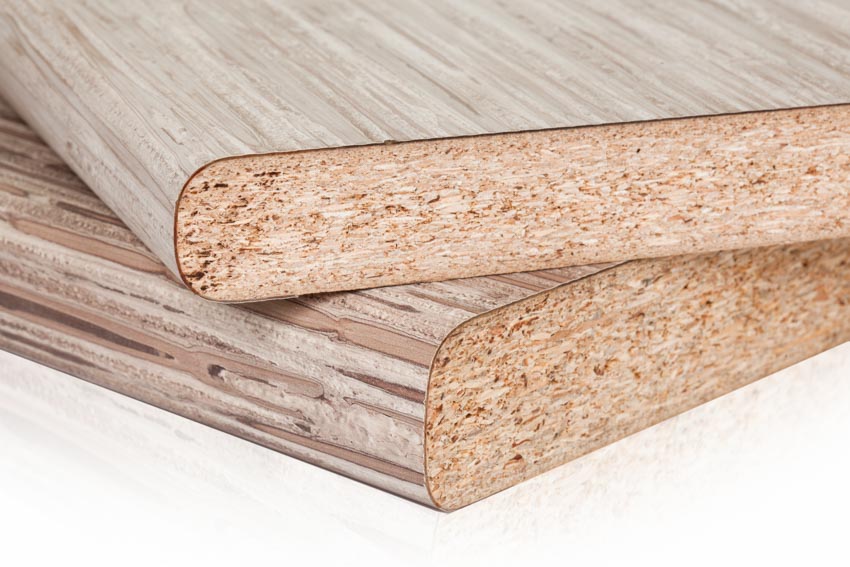
Together with a synthetic resin or binder, the particles are pressed and extruded together under high pressure, binding the wood pieces together into a sheet of board. The boards are then cut to size and sanded down to meet the various standard thickness.
The standard size of particle board in thickness ranges from 12mm to 38mm. Like plyboards, particle board is available in the standard 4 feet by 8 feet boards. Due to the varying sizes of the wood particles, the pressed chips usually have small voids, with makes the surface rough and will need sanding to smoothen the surface.
Homeowners can opt for RTA or ready-to-assemble particle board cabinets or construct their own customized version. The material particle board cabinets cost 10 to 20 % cheaper than plywood cabinets and even cheaper than your solid wood cabinets.
Most affordable cabinets today have sides and backs made from particle board and a more durable wood board used for the doors and flooring. Other terms for particle board are particleboard, LDF, or low-density fiber and chipboards.
Aside from kitchen cabinets, particle boards as furniture are an excellent choice for open shelves or wall types of shelves due to their lightweight construction.
Pros and Cons of Particleboard
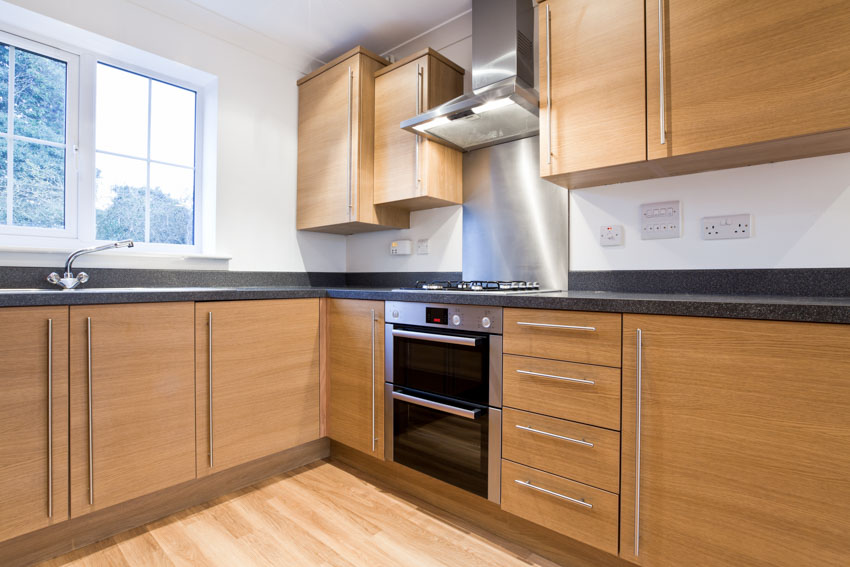
Like any product, it is best to weigh the pros and cons of particle board kitchen cabinets before making a decision on which type of material to use.
Whether buying off-shelf furniture or making one from scratch, basing your choice on your purpose is crucial to making sure you get the most of your money and time.
Pros of Composite Boards

1. Affordable: When cost is a greater concern than durability and appearance, particle board cabinets are a practical choice. Particle board cabinets are made from laminated types. The particles are basically shredded wood, taken from other sources like discarded lumber,
2. Lightweight: A denser built but lighter compared to cabinets made from hardwood boards and most engineered wood boards. This makes it easier to handle and convenient for a DIY assembly. Hanging or floor-to-ceiling cabinets make it possible without damaging the walls.
3. Good Screw Holding Capacity: Compared to MDF cabinets, particle boards’ dense construction composed of wood chips makes it easy to assemble using screws. However, repeated disassembly or assembly can loosen the board’s ability to be used. The screw holes will eventually loosen or lose material which will require refilling.
4. Stable and Uniform Structure: With a homogenous density, particle board kitchen cabinets have a low volumetric swelling or easily warp when exposed to moisture, especially when veneers are in place.
Particle boards are the preferred construction material for many cabinet manufacturers due to their ease of use. It is easy to manufacture and manipulate and stays consistent across all dimensions.
5. Insulating Properties: Though not mainly an important feature in furniture, the thermos-acoustic insulation properties of particle board kitchen cabinets can act as an additional advantage to buffer sound between rooms. Muffling sounds are great to keep the echo down, especially in locations that are surrounded by concrete walls.
6. Requires Minimal Maintenance: With an extra layer of veneer or laminate cover, particle board cabinets are basically easy to clean and maintain. The impervious surface prevents dirt or moisture from seeping through, making it easy to wipe off spilled liquid or dirt.
Cons of Composite Boards
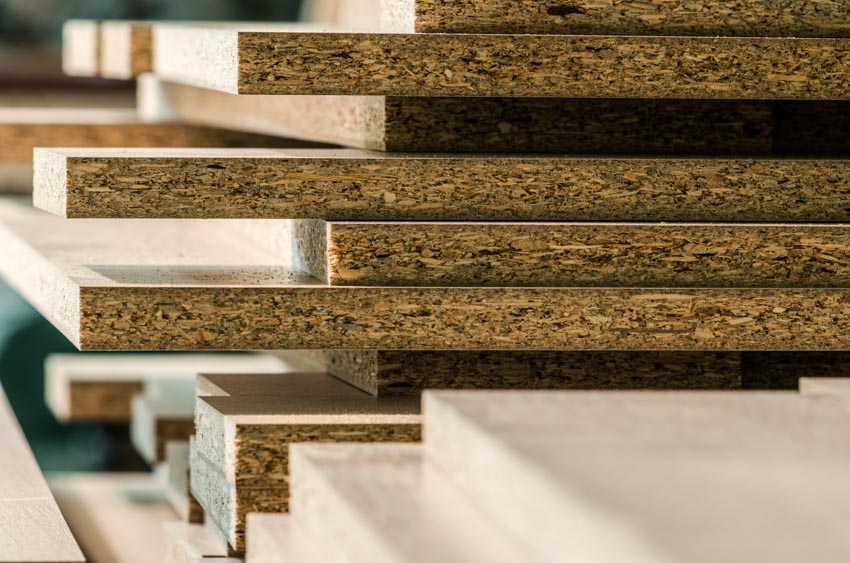
1. Cannot be Refinished Easily (if not impossible): Particle boards are affordable, but as they say, you get what you pay for. With plywood it’s much more versatile when it comes to restoration. It can be sanded and painted over when necessary.
This is a luxury that is not easy to do with particle boards. Depending on the damage to the particle board, you can only get away with so much when it comes to painting the material. Particle boards are typically covered with a veneer that is water resistant. Replacing it means tearing off the veneer and replacing it with a new one.
Painting over a veneer is not the best option since, as mentioned, these are water resistant; they have to be either removed or sanded first for a fresh coat of paint to adhere to the surface. A replacement is required if the particle board is damaged by water evidenced by bloating.
3. Will Warp When Exposed to Water:Kitchen cabinets made from particle board that is subjected to continuous exposure to moisture or water can warp over time. In the worst case, the discoloration can also happen to the surface, prompting a replacement or repainting.
Water is not the only issue with particle boards, and molds can also be an issue with particle boards. With the introduction of water, a particular fungus that grows on wood can break the wood fibers apart. It’s the same fungi that cause wood rot.
Apparently, termites aren’t the only ones that can cause wood to degrade. Unless the manufacturer added fungicide to combat this particular mold, you would need to take extra measures to keep the particle board from getting wet.
3. Less Durable: Solid wood is more expensive than particle boards because they take time to grow, typically decades, as opposed to particle boards made from shredded wood that is glued together.
Again, you get what you pay for, and particle boards are not expected to last long, depending on where they are used, specifically the environmental conditions. Furniture made from solid lumber can last decades that can basically pass down generations, whereas particle boards, you’d be lucky to get a decade out of it.
4. Can Release Harmful Toxins: One of the biggest disadvantages to using particle boards is the use of toxic chemicals used to glue the wood together. Depending on who manufactured it, they could have used urea formaldehyde.
This chemical will release formaldehyde gas over time, which makes it even worse when the wood is burned when discarded, thinking it’s all fine. We mentioned fungicide earlier. It’s not certain if fungicides are added; there seems to be no solid evidence for it, but just in case the manufacturer added fungicides, that’s something to take note of.
5. Weak in Strength: Particle boards are heavy, but ironically, they can’t support a lot of loads by comparison. After all, it’s just wood particles held by glue. When deciding whether to go for particle board or plywood, it is important to consider what it will be used for and how much weight it is expected to bear.
How Long Will These Pressed Wood Types of Cabinets Last?

On average, particle board cabinets can be used for around 3 to 5 years without significant damage, and at this point, a replacement or repair of your cabinets may be required.
As most particle board cabinets are made with a veneer covering, the band edges on your cabinets are the most likely to peel off first.
How to Clean These Particleboard Cabinets
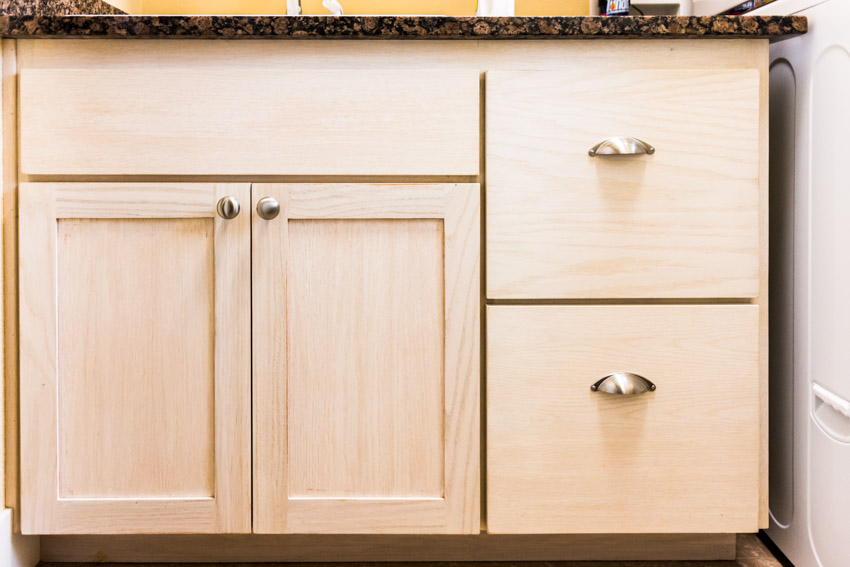
As most particle board kitchen cabinets are covered with veneer or laminate, you can clean off accumulated dust or debris with a damp cloth. Another option is to use a water and vinegar solution. To remove grease, use warm water with your vinegar. Use equal parts of vinegar and water in the solution.
Discoloration can happen on your cabinets, especially when you have low-quality types of wood veneer. Make sure to test your cleaning solution on an obscure part of your cabinets before applying it to the whole surface. Also, be sure to keep your particle board cabinets dry. Wipe out liquid immediately on the surface to prevent water from seeping through.
For stubborn dirt on the particle board, make sure to use minimal water and rub the board with less quantity of water. Clean it immediately with a dry cloth. Always use a slightly damp cloth or dry the area immediately after cleaning the board with water, as particle boards are prone to moisture.
Can You Paint Them?
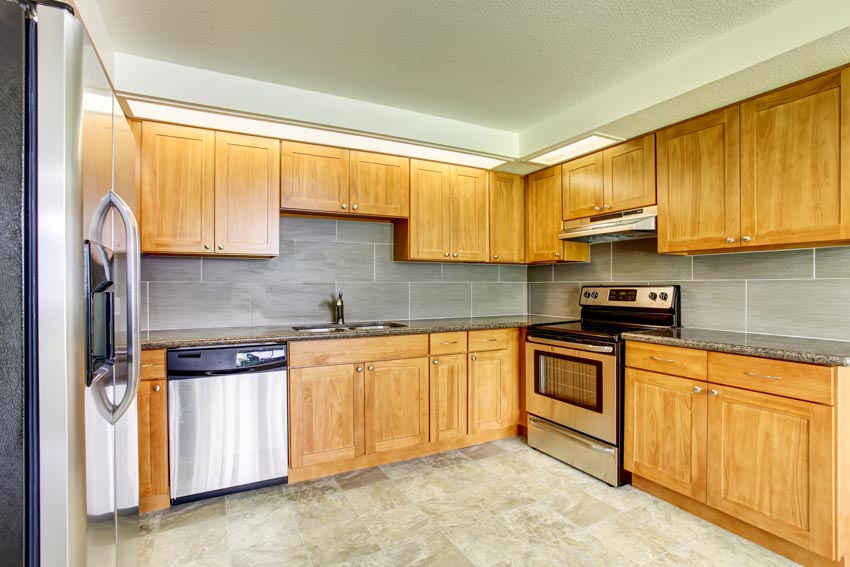
The short answer is yes. In fact, this is a must, especially when you are planning to use it in locations with high humidity, like the kitchen and bathroom.
Painting Pressed Wood Cabinets

Before you reach for the paintbrush, it’s best to do some inspections first. Particle boards tend to break apart, particularly in areas where screws have been driven in. Material loss in this area means your screws will eventually come loose or won’t grip. If this is the case, then use the proper chemical to fill it in.
You might want to also check for other types of damage like warping or bloating caused by moisture. Once you have checked and determined it suitable for simply repainting job, then you can proceed with the painting.
The first step in painting a cabinet is the same as painting a wall. You’ll want to prepare the room by using drop cloths in areas where you will be painting and taping off areas where you don’t want paint applied.
You will want to remove the doors from the cabinets in order to properly work with them. Make sure you clean the cabinets before painting so that the any grime will not adhere to your sanding pads. You will also want to remove all of the cabinet hardware.
You start off by sanding off any existing paint or peeling off the veneers. Light sanding is more than adequate for this first step, and avoid using a sander as this is just too powerful for the job.
Once the sanding is done, you can apply the first coat of primer. Be careful with your primers; there are two main types, one for concrete and another for the wall. Make sure that you are using the one for wood. So paint the primer over, then wait for it to dry.
Read the instructions on the container, as it will tell you the recommended drying time. Once that’s done, you can apply a second coat of primer and then wait again. Once you have a solid color, you can now proceed to paint it with your desired color.
Wait again for it to dry and do some light sanding, then apply a second coat of the same paint. Repeat this process until you can see the color is consistent throughout the surface. Skipping the sanding process can result in uneven colors. Make sure to wear the proper equipment when sanding paint, and if possible, do the work outside.
At its most basic level, the clever interior design improves a space by increasing its functionality. When decorating a bedroom, for instance, you would make decisions that would improve the space. Focus and productivity will increase in a well-designed office.
Having good design extends beyond aesthetics. To ensure that every element in the room has a purpose, the excellent design goes beyond ornamentation and opulent furniture. We excel in producing excellent designs, whether they be in the realm of interior or exterior architecture. Practice proper precautions when doing paint jobs.
Video On How to Paint Particle Board Furniture
Can You Reface Such Cabinets?
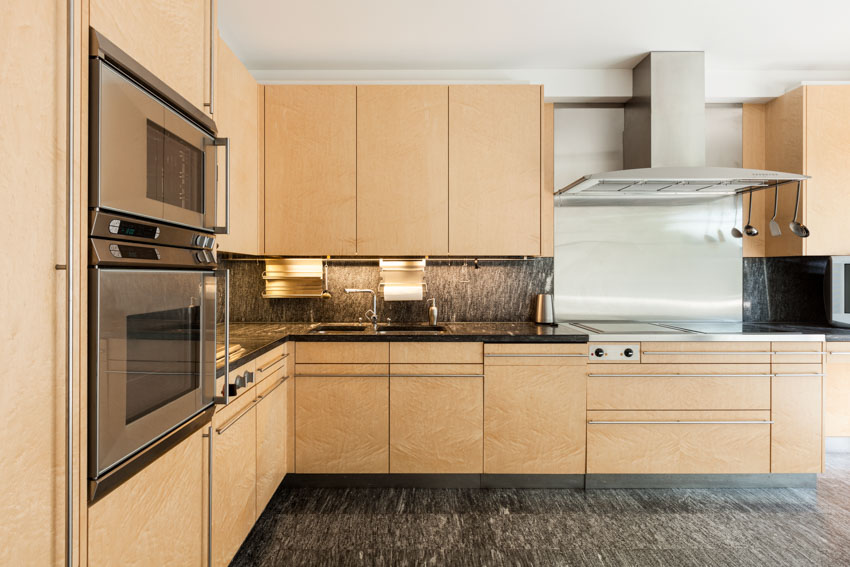
Particle boards come with a veneer that protects the surface. Avoid scratching or denting it. Otherwise, your only option is to paint it over. Fillers are needed when working with particle boards.
Water is definitely an enemy, and any amount can cause damage. That’s why manufacturers typically add oils. But this also becomes a problem when attempting to paint it over. Read more about refacing kitchen cabinets here.
How To Repair Water-Damaged Cabinets?

Dry the cabinets with a rag and remove soft or water-damaged parts of the board with a screwdriver. Fill dips and divots in the cabinet with wood filler, sand it to even it out, and clean the surface. Apply a sealer to the wood filler and vacuum the area to remove wood particles and dust.
How to Repair Peeling Veneer on Cabinets
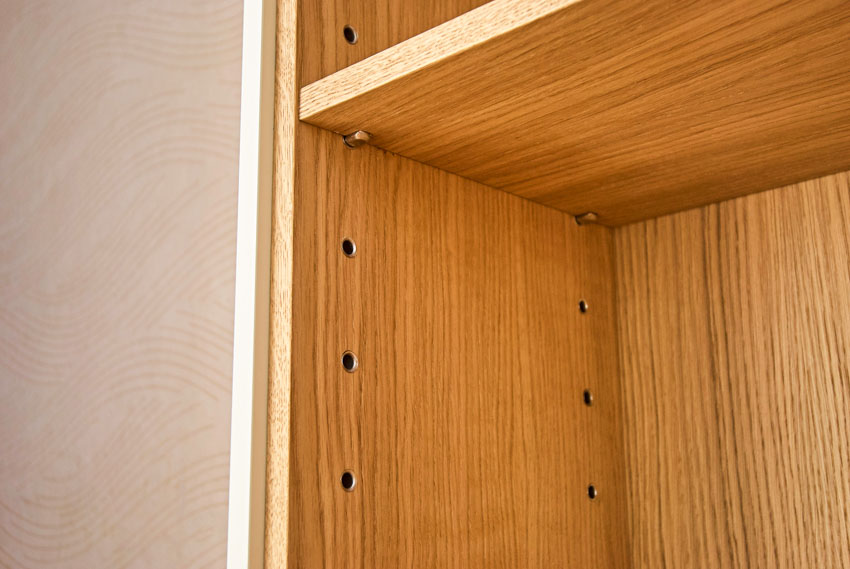
Using a paintbrush, apply contact cement to both the particleboard and the underside of the veneer. Ensure you continue to pull the veneer away from the particleboard, as you don’t want the cement to touch until it’s dry. Once the contact cement has dried, push the veneer against the particleboard.
Best Screws for these Cabinets
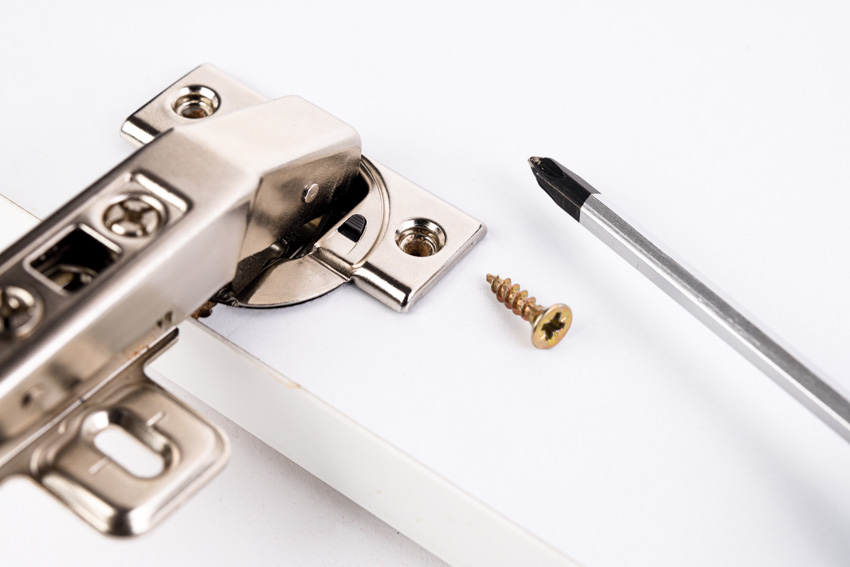
If you ever assembled wooden types of furniture styles, you would have likely come across particle boards, a type of construction lumber that has a similar make to cork boards. This lumber is easy to work with if you can get around the weight issues.
Since the board is really just an amalgam of glue and various types of sawdust, it doesn’t have the ideal make for using nails. Screws are the best way to keep two or more pieces together.
But which types of screw should you use? The wider or thicker threads are easily identifiable as normal screws meant for wood. A proper screw for particle boards would have a similar characteristic. Here’s a list of some that will work. Screws are made from a variety of metals like steel, carbon steel, or brass.
Hillman Screws: Hillman screws are not that far off from your typical wood screw; it comes with a Philips-style head, so you don’t have to go hunting for a special screwdriver for them. It also comes in a variety of sizes for different applications.
SPAX Screws: Spax screws are specially designed to go into particle boards and MDF material. One of the biggest challenges to screwing is getting the screw to bite onto the surface. SPAX has teeth to help it grab onto a surface as you use your power drill to drive it.
It also comes in a variety of head styles. There’s a hex washer style that will require a wrench; the other style uses the T-Star head style, so you will need to make sure you have this screwdriver for it.
As far as head styles are concerned, it’s not just those mentioned above; there are other types like flat heads and countersunk flat heads. Pan head and oval are also options, but the most common ones are pan head and flat head.
How Do These Types Differ from Plywood Cabinets

Cost: When cost is the issue, plywood will always be the more expensive; particle boards are more affordable since they are made from recycled material: wood grounded to powder and glued together in a mold to form the shape it has. Manufacturers can add veneers to protect the surface.
Durability: Plywood is the better choice when it comes to durability. A well-planned construction will guarantee a stronger build depending on how many layers of plies are used and how much weight it is intended to support. Wood chipboard has a poorer tensile strength compared to plywood.
With that being said, particle boards are not that far when it comes to durability, but this also requires that the quality of the board is within standard limits.
An issue with wood chipboards, particularly furniture that is assembled and disassembled repeatedly, is that screw holes tend to “corrode” or break apart (that is, the wood particles break off). Use wood chipboards in applications where it is permanent.
Longevity: Moisture is an enemy of both types of lumber, but wood chipboards are most likely susceptible to warping since the wood is practically a sponge. There are ways to prevent moisture damage by applying paint or chemicals at the edges to keep water out.
Plywood can withstand water damage initially but will eventually rot, so it still requires protective coatings for longevity. Never use wood chipboards in environments where moisture or water is expected, even with all the protective coatings. It’s best to just be safe and use plywood instead.
Are These a Better Choice Over Plywood Cabinets?
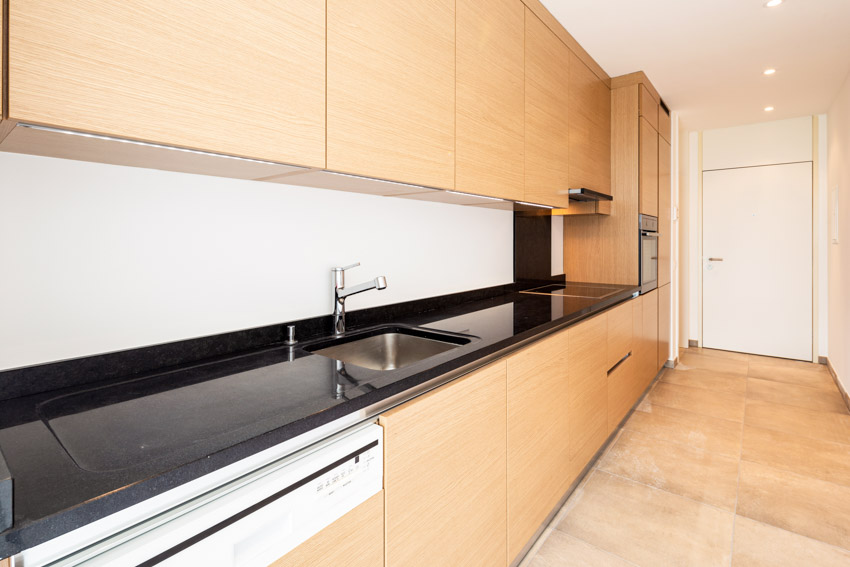
Preferably, plywood should be the go-to material for any woodworking task. It is lighter and is more resistant to moisture as well as warping. It’s just better overall. Any furniture made from thick plywood can be assembled using either screws or nails. You could get away with nails when using wood chipboard, but the lack of threads will just let those nails slip off, so it’s best not to risk it.
There are also rumors going around that either the glue or wood particles used in wood chipboards might be toxic, and inhalation of said particles while sawing is a risk. That’s why you should make sure to purchase your boards from a reputable dealer.
But even without the toxicity, some people are sensitive to dust or have respiration issues. If this is still something you are concerned about, you should opt for plywood instead.
Wood chipboard cabinets are great for certain applications and locations. This is why it is important to conduct some research first. Whether you are an interior designer working for a client or a homeowner simply looking to do some renovations at home, studying the pros and cons of wood chipboard cabinets will go a long way to get the most out of any money spent on the project.
Money is going to be the greatest determining factor when trying to pick between the wood chipboard and other alternatives like monobloc or plywood. Safety might be the next concern, and it really depends on your client’s preferences.
When quality is the priority, anything but wood chipboard should be the choice. That can be solid lumber or plywood. They last longer and are not sponges for water. Wood chipboards can also bow over time; when this happens, the screws that hold that particular piece won’t be of any use.
If it’s a major piece of furniture that’s bent out of shape, it can be impossible to assemble it back even if the other parts are still okay. Solid wood also won’t emit toxic gases and can support heavier loads.
If you are looking for a cheap alternative that you don’t plan to keep for a long time, then you can use cabinets made of particle boards. You just need to heed the different cons mentioned in this article.
See more related content in our article about inset kitchen cabinets on this page.


